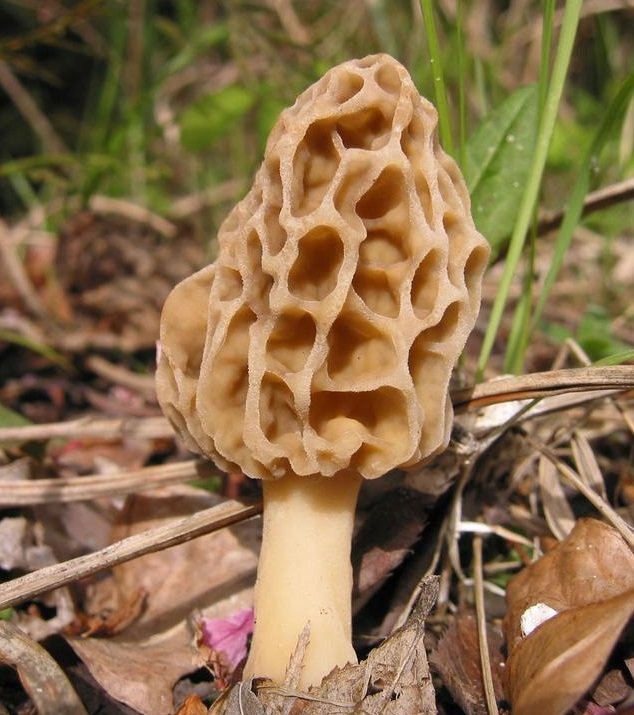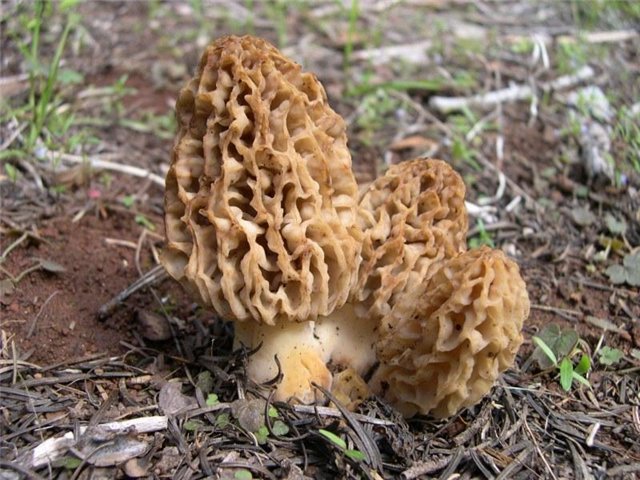morel (Morchella esculenta)
- Department: Ascomycota (Ascomycetes)
- Subdivision: Pezizomycotina (Pezizomycotins)
- Class: Pezizomycetes (Pezizomycetes)
- Subclass: Pezizomycetidae (Pezizomycetes)
- Order: Pezizales (Pezizales)
- Family: Morchellaceae (Morels)
- Genus: Morchella (morel)
- Type: Morchella esculenta (Edible morel)

Fruit body edible morel is large, fleshy, hollow inside, which is why the mushroom is very light in weight, 6-15 (up to 20) cm high. It consists of a “leg” and a “cap”. Morel edible is considered one of the largest mushrooms of the morel family.
head in the edible morel, as a rule, it has an ovoid or ovoid-rounded shape, less often flattened-spherical or spherical; along the edge tightly adheres to the leg. Cap height – 3-7 cm, diameter – 3-6 (up to 8) cm. Cap color from yellow-brown to brown; becomes darker with age and drying. Since the color of the hat is close to the color of fallen leaves, the fungus is hardly noticeable in the litter. The surface of the cap is very uneven, wrinkled, consisting of deep pits-cells of various sizes, lined with hymenium. The shape of the cells is irregular, but closer to rounded; they are separated by narrow (1 mm thick), sinuous folds-ribs, longitudinal and transverse, colored lighter than the cells. The cells vaguely resemble a honeycomb, hence one of the English names for the edible morel – honeycomb morel.
Leg the morel is cylindrical, slightly thickened at the base, hollow inside (makes up a single cavity with a cap), brittle, 3-7 (up to 9) cm long and 1,5-3 cm thick. In young mushrooms, the stem is whitish, but darkens with age, becoming yellowish or creamy. In a fully mature mushroom, the stem is brownish, mealy or slightly flaky, often with longitudinal grooves at the base.
Pulp the fruiting body is light (whitish, whitish-cream or yellowish-ocher), waxy, very thin, fragile and tender, easily crumbles. The taste of the pulp is pleasant; no distinct odor.

spore powder yellowish, light ocher. Spores are ellipsoid, smooth, rarely granular, colorless, 19–22 × (11–15) µm in size, develop in fruit bags (asci), forming a continuous layer on the outer surface of the cap. Asci are cylindrical, 330 × 20 microns in size.
The edible morel is distributed throughout the temperate zone of the Northern Hemisphere – in Eurasia up to Japan and North America, as well as in Australia and Tasmania. Occurs singly, rarely in groups; quite rare, although the most common among morel mushrooms. It grows in well-lit places on fertile, lime-rich soil – from lowlands and floodplains to mountain slopes: in light deciduous (birch, willow, poplar, alder, oak, ash and elm), as well as in mixed and coniferous forests, in parks and apple orchards; common in grassy, protected places (on lawns and forest edges, under bushes, in clearings and clearings, near fallen trees, along ditches and along stream banks). It can grow in sandy areas, near landfills and in places of old fires. In the south of Our Country, it is found in vegetable gardens, front gardens and lawns. This fungus develops profusely in spring, from mid-April to June, especially after warm rains. It usually occurs in forests on more or less fertile soil under deciduous trees, more often in grassy, well-protected places: under bushes, along ditches, on lawns in parks and gardens.
In Western Europe, the fungus occurs from mid-April to the end of May, in especially warm years – from March. In Our Country, the fungus usually appears no earlier than the beginning of May, but can occur until mid-June, occasionally, in a long warm autumn, even in early October.
Edible morel cannot be confused with any poisonous mushroom. It is distinguished from related species by the conical morel and the tall morel by the rounded shape of the cap, the shape, size and arrangement of the cells. The round morel (Morchella rotunda) is very similar to it, which, however, is often considered as one of the forms of the edible morel.
Conditionally edible mushroom of the third category. It is suitable for food after boiling in boiling salted water for 10-15 minutes (the broth is drained), or after drying without boiling.
Video about the mushroom Morel edible:









